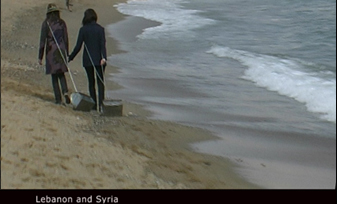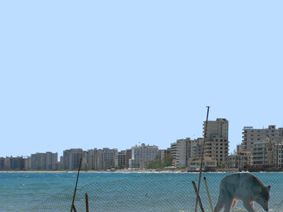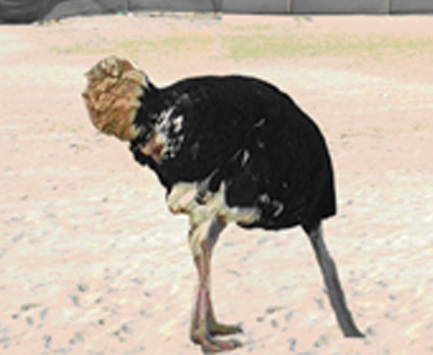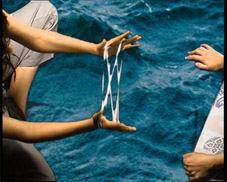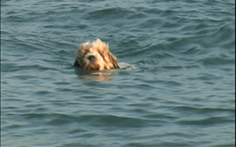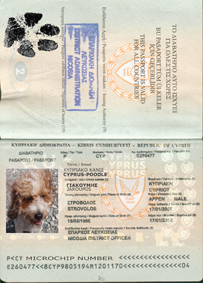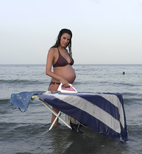 |
“Blue
Period-Woman
ironing flag”, 1:11minute, 2016.
For three years 1901-1904 Picasso began to tint his paintings a pale
cold blue viewing the world through blue spectacles. A “Woman ironing”
was painted in his Blue period touching upon
social compassion and urban proletariat,
themes currently shared by Greece and EU migration crisis. Filmed
in Larnaca -Cyprus
|
 |
"Silences | Here I stand ironing"
4:51min, 2016
A woman
stands in an empty white room ironing a Greek flag. While ironing she
listens to an audio of a short story by Tillie
Olsen “Here I stand Ironing”. In the video we hear an extract of this
story.
The Greek flag to many Cypriots is the “Mother-land flag”, Olsen’s story
is about a mother and daughter and takes place
in the most ordinary of settings: a mother, at home, ironing. The mother
is interrupted in the course of her routine by a troubling question from
her daughter's teacher. |
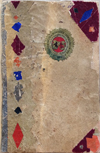 |
"Asia Minor diary in karamanlidika text" 3:08min, 2015
One-off copy, 53pages, 30x43cm.
Amended exhibit found in Byzantine Museum Cyprus.
Decoding of text; a collaboration of a Greek and Turkish speaker. |
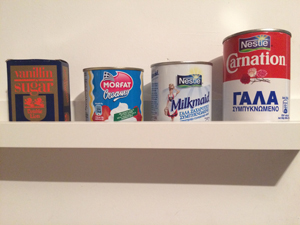 |
"White-Desire ICE-CREAM, Re-materializing Post-colonial Cyprus" 6:23
min, 2015
A recipe of processed food. An exclusively pale white ice-cream recipe
“imported” to be consumed by the idealized primitive subjects. This
traditional ice-cream recipe was first published by the Larnaka ladies
society in the early 1960’s and passed from one generation to the other
(also seen on package). Still a popular recipe today. Desert-White
Desire, an exclusively pale white ice-cream perhaps “imported” to be
consumed by the idealized primitive subjects? |
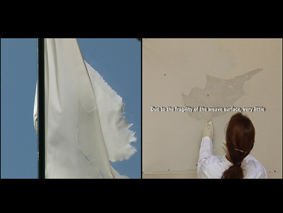 |
"The shroud of Cyprus/
H σινδόνη της Κύπρου"
Double video projection, 5:25 minutes 2014.
Left screen
- A faded, worn, torn Cyprus flag flies in silence on a mast eternally
against a blue sky. The cause of how it got to this state is not clear,
has it been forgotten, a veteran of many battles, or just simply
weathered?
Right screen
- Via a
specialized art
conservator procedure, the flag has been
preserved on a stretched canvas to be placed in a protective
glass-frame. Like a holy shroud, a museum masterpiece, or even a family
heirloom, it is aimed to be exhibited. |
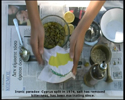 |
"Recipe for Marinated crushed olives",
3 min,
2006.
Local olives
in Cyprus are prepared in this way as early as the Byzantine era. The
film makes an
ironic paradox between the Cyprus problem and the making of Crushed
Olives; that it is
split, salt has removed bitterness, and has been
marinating since (1974).
This recipe is filmed on a daily Cypriot
newspaper with the following headings:
a) The European parliament has obliterated
the Cyprus problem, the Cyprus problem is not a priority,
b) We are not as similar as we think…
|
 |
"Olives in Syrup",
3 min,
2007
Γλυκό
του κουταλιού της ελιάς»,
this family secret recipe has been
prepared in this way as
early as the Byzantine times. Women mostly offer it to men when delicate
issues are to be raised.
RECIPE FOR OLIVES IN
SYRUP
Ingredients
- 250gr green olives
(harvested in October while they are still green and unripe)
- 200gr water
- 300gr sugar
- Shavings of 1 lemon
- Juice of 1 lemon
- Secret magic spice
Method (as seen
on film)
1. Pip olives 2. Boil
sugar in water for 5 minutes 3. Lower fire and place olives in syrup 4.
Add lemon juice and shavings
5. Finally add “secret
spice” and simmer olives until syrup thickens.
Store in glass jars,
crochet the top of lids. Do not underestimate the symbol of olives.
Serve with Greek coffee
(others call it Byzantine or Turkish coffee) with a glass of fresh water
on the side. |
 |
"Ελιόψωμο |Olive
bread",
7:00 minutes, 2010
A retired man remembers a story while
piping olives. His friends visit him and they continue chatting about
the old times, politics, aneurysm and food. His wife makes olive bread
while listening to them chatting away. |
 |
“Rembetiko” (three
screen installation) 9min 14”, 2010
Rembetiko, is a term used today to designate originally
disparate kinds of urban Greek folk
music. Its lyrics reflect the harsher realities of a marginalized
subculture's lifestyle. Breaking
plates is an ancient Greek tradition. It was a way of mourning the
deceased. After the commemorative feast was served, the guests would
smash their plates as a way of breaking curses and scaring away evil
spirits. Today, breaking plates is most commonly thought of in a
celebratory way, with
the Greek concept of kefi (high spirits and fun) but at the same time
trying to scare off and forget the daily troubles. Each plate
has an image of Pendadactylos mountain range in Cyprus, with the slogan
“Do not forget”, the peak name and height. |
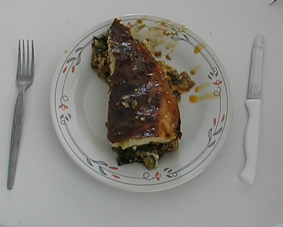 |
“Μουσακάς
| Moussaka”,
6:31minutes, 2012
The Greek national dish, Mousssaka, - includes an inch of French
bechamel cream sauce and 700 calories per serving. The story behind this
dish starts in the early 1900. Tselementes, a Greek chef, believed that
French cuisine was much more sophisticated than the simple Greek food,
and developed recipes and cooking styles based on sauces and French
methods of preparation to "cleanse" Greek food of Ottoman and Middle
Eastern influences that had been incorporated over centuries,
influences Tselementes saw as barbaric.
|
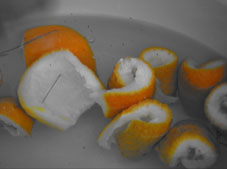 |
"Divide and Consume",
3:18 minutes, 2010
Sweet Recipe of Orange peel: Ingredients : 1kg orange
peel/ 1 kg sugar/3 cups water/o.5 lemon zest. Peel oranges. Roll peel
into tubes and fix them together with needle and thread. Soak for 5
days, changing water daily. On the 6th day add sugar, lemon
juice and simmer until syrup is ready. The video takes on a metaphor for
the politics of British colonization in Cyprus via a traditional Orange
recipe.
Filmed in Strovilia, Famagusta District, within the
British Sovereign Bases. |
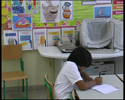 |
"Grade IV [Δεν ξεχνώ]",
3 min, 2007“
I will love
my neighbor” is a hand-written repetitive message written inside notebooks of
all grades in elementary schools in Cyprus.
These notebooks have “I do not forget”
printed
on the
back and front cover.
Δεν ξεχνώ
is a phrase slogan still used since 1974 whose objective is to support the
long-term struggle against the Turkish military occupation in Cyprus.
|
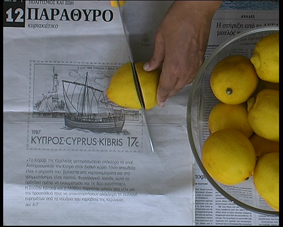 |
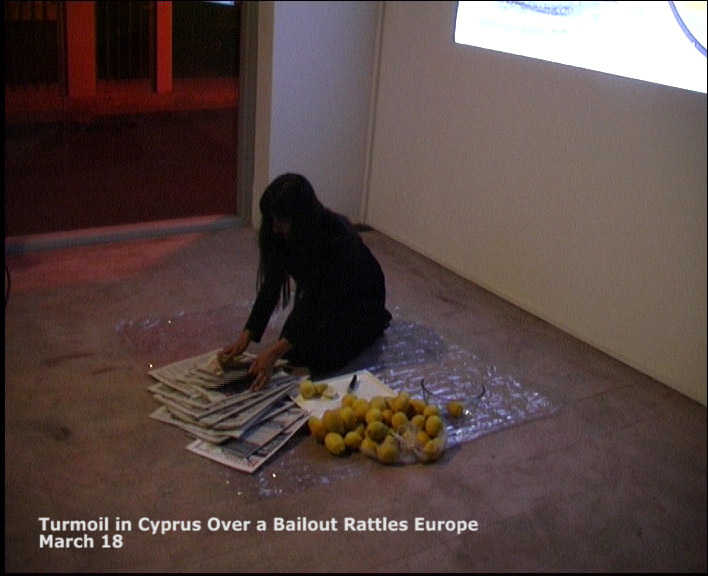 |
Cyprus
17cents,
2013
The artist performs her ritual of erasing
stacks of newspaper headlines with lemons.
A double-projection, one showing a close up of lemons, symbol of Cyprus,
erasing an image of a Cypriot stamp from a newspaper (it costs 17
cents), the other projection a documentation of the performance.
|
 |
"How do we know it is
Aphrodite?" 3-channel video installation, may be viewed separately
also, 2012
Video 1;
Video
2; Video 3.
Video of installation |
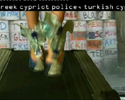 |
"Should I stay or should I go now?",
1 min, 2006
Cyprus
has been described as the most militarized countries in the world, 19
soldiers per squared kilometer. Third highest world weapon holding
891000 per 1 million people.
The
film was inspired after the Cyprus border opened in 2003. A playful,
darkly humorous short film loaded with contradictions and symbols. With
the border as a background, the protagonist sings the words of the Clash
out-of tune, while running in heels on a treadmill which is symbolic of
the isolated islander, as well as the Cyprus problem that seems to go
nowhere. |
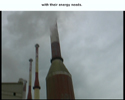 |
“Electricity”
2:30 min,
2006
“Electricity”is part of a Tetralogy of four interconnected short films
on contemporary Cyprus, including ”Rabbits have no memory”,
“Marinated Crushed Olives” and “Should I stay or should I go now?”. The
films oscillate between narrative politics, archive documentary and the
experimental.
This short experimental
documentary starts with CyBC-radio music of Occupied Cyprus, continues
with electricity manufacturing sounds and ends with an Ottoman military
march beat. An experimental documentary of the islands separate
identities, impregnated with my own personal sadness and disbelief;
the last time I felt sad
was when the largest flag in the world, 1000m, was placed in my back
garden. The flag is on the North Pentadactylos Mountain, the Turkish
National flag and has written underneath ‘so happy to be a Turk’ and in
reverse colors is the ‘Turkish-Cypriot’ Republic flag. This flag all
through every night at 8pm lights up and is extremely provocative to an
unresolved Cyprus problem.
<from 1963 to 1974 the
Turkish Cypriots were given free electricity. This continued also after
the invasion of the Turkish army in 1974 at a cost of US dollars343
million, even though apart from the Turkish Cypriots the consumers now
included the Turkish occupation forces. The Cypriot authorities still
supply the occupied areas and their army with their energy needs>. |
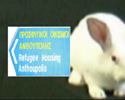 |
"Rabbits have no memory",
1min 55 sec, 2006
The
film, enigmatic, abstract, a puzzle to be decoded, with minimal clues of
“Cypriots” which most of them might even be false (casino, displaced
persons (refugees) housing, rabbit, barking dogs, gun point +shot) and a
text, a memory reading by a ‘patronising neo-colonial’ visiting Cyprus.
The
British colonists lacked respect for the Cypriots, and this British
superiority may not only be read in W.Hepworth Dixon “British Cyprus”
(1887) but also in Durrell’s
“Bitter
Lemons” (1957). This is a story of his experiences on Cyprus between
1953 and 1956--first as a visitor, then as a homeowner and teacher, and
finally as press advisor (spy?) to a government on the verge of
revolution. In
brief, Durrell characterises the Cypriots as happy childlike innocents,
misled by “demagogues” and the “envenomed insinuations of the Athens
Radio». The English, on the other hand, are seen as always concerned
with the good of the charges that they have been entrusted with.
He
writes about Cypriots: “….
It was unreal. One has seen rabbits scatter like this at the report of a
gun, only to re-emerge after half an hour and timidly come out to grass
again- unaware that the hunter is still there, still watching.
Civilians have no memory.
Each new event comes to them on a fresh wave of time, pristine and newly
delivered with all its wonder and horror brimming with novelty.”
L.Durrell “Bitter Lemons “ 1957p.196
|
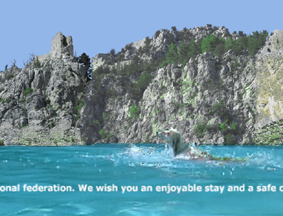 |
"C h a n g e o f a
ι
r
| Αέρας
αλλαγής |
Ηava
değişimi",
1:50 minutes, 2009
The text below simply describes a post-solution era if
accepted in a January 2010 plebiscite by the Cyprus population. In the 3
official languages of Cyprus.
Welcome to our new bi-communal, bi-zonal federation.
We wish you an enjoyable stay and a safe onward journey.
Καλώς ήρθατε στη νέα μας δικοινοτική, διζωνική ομοσπονδία.
Σας ευχόμαστε μια ευχάριστη διαμονή και
καλή
συνέχεια.
Yeni iki toplumlu, iki bölgeli federasyona hoşgeldiniz.
Ziyaretinizin keyifli, yolculuğunuzun devamının güvenli olmasını dileriz. |
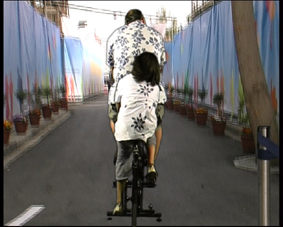 |
"It
is Spring-time and I am still living in Cyprus"
2 min,
2008.
The film shows glimpses of Ledra Street
being a reflection of the recent history of Cyprus. Ledra Street is in
the centre of the last divided city of Europe, Nicosia that had been
closed off since 1963 and re-opened in spring 2008. An allegory on the
way we live today is portrayed via the father and son cycling through
the new check-point passage from one side of Ledra Street to the other.
Cypriots are overall peace-loving people, in the film, the father and
son do not sing in their local language, a reflection of how “adaptive”
the Cypriots have had to become as a result of the millennia of the
occupation of different forces and colonial powers. |
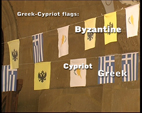 |
"Reasons for War",
3 minutes
Religion
and Nationalism are often used as excuses for War.
The film
explores the Greek-Cypriot dual identity to their Ethnic and Religious
origin. Symbolic to this, is the Greek celebrations of
March 25 that is both a
National (revolution against the Turks) and religious holiday
(Annunciation). Situated across the church, checkpoint (Charlie) in
Nicosia shows the inherent tension of Cyprus bi-ethnic state.
The nostalgic “Torn between two lovers” song is superimposed throughout
the film, a 70’s tune of a time long ago, perhaps a longing to be able
to live together. Many wonder whether Cyprus political problems are
fueled so as to ensure that the “great powers” can better control the
island, and its strategic position in the Middle East. |
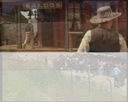 |
"Cyprus, a Cowboy Frontier Land"
2:10 min,
2008
A clip of Americans’ moving towards the frontier
line from a clip of the film Tombstone by George Cosmatos (1993) is
superimposed with CyBC archive showing Cypriots moving either side of
the demarcation line in 2004. UN peace-keeping forces in the dead-zone
are overlooking the crossing.
As the
“government” of the occupied North of Cyprus is not recognised by any
country other than Turkey, there are no extradition treaties between
this area and the rest of the world. As a result it has become a haven
for villains escaping justice from the rest of the world, a “wild west”.
Note:
Greek film director George Cosmatos was raised in Cyprus
and was
a close friend of my father’s. In Cyprus, he filmed
Exodus in 1960 (with Paul Newman),
though he
was best known for the 1993 western Tombstone, Rambo II
and Cobra. |
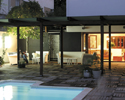 |
"14 Demosthenous street",
4 min,
2007,
Greek (with French subtitles)
The film records a tour
of a house in South Cyprus in which the enclaved children stayed during
their secondary schooling prior to the re-opening of the first and only
Greek gymnasium in the Rizocarpaso in Northern occupied Cyprus. No
traces of the children’s’ stay are found in this renovated house, merely
second hand memories past down to the new owners, which have tried to
keep some of the old features of the house.
The film touches upon
living in partition times where traces of dislocation can be found even
in the most unexpected places, a common suburbia house in 14
Demosthenous street.
After the 1974 war,
there were about 20.000 mainly Greek-Cypriots that were cut-off in the
Northern Karpass area. These people remained in their village in the
hope that following the cease-fire, they would be able to carry on with
their normal life. By 2006 only 518 people, mostly elderly, remain
there. |
 |
"Taking a bird for a walk",
3
min,
2007
In
all the recorded history there has never been one day that a battle
hasn’t raged somewhere in the world. Peace is very elusive…
A short, seemingly insignificant journey. A 9 year old
boy tries to take a dove for a walk. He has lured the bird by feeding it
along the way. Two doves then fight for the food trying to balance on
the boys shoulder, the dominant one stays on. The bird is indeed hard to
lure…one minute he has it and the next it is gone. |
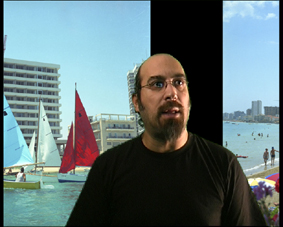 |
"History in the making",
3:30 min, 2008
In the foreground a
poet/journalist gives a monologue as if reading from a text that has
never been written. History is lost in the torrent of information. He
begins with 4 dates, 2 are only correct that alludes to the hush-up,
omissions, historical inaccuracies, mistakes and avoidance of giving
emphasis to the facts. Important word symbol is that of the “mouth” that
is the oral passing down of history from generation to generation,
although this includes all the variations and distortions, arbitrary
falsifications that occur while re-telling stories.
Apart from words, images from PIO (Public Information
Office) archive scroll in the background taken prior to the war until
recent events, mostly from demonstrations by Greek Cypriots to cross
over the divide,
from
peaceful times and from newspaper articles on history textbooks for
secondary education. Through the reality of the image and the subjective
intentions of the poet/journalist, the viewer is called to reflect on
the recent past history of Cyprus and to materialize the making of
tomorrow’s history. If
peaceful living is to be accomplished in Cyprus, which images/books
shall be selected to be taught
to the new generation??
"History
in the making"
Subtitles |
| |
|
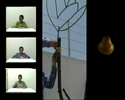 |
"Grafting/All my children",
3 min,
2005.
Grafting is a term used when a different variety is
‘attached’ onto a rootstock. It is used mainly on fruit trees to
spread out the different varieties to mature at different times or to
improve the original tree’s performance. It is an allegory to what
constitutes today a family (tree). i.e. family whatever this means in
this mutated era. The film is split in 3 parts.
The left screen shows raw 1998 video footage of children
and friends which were asked to sit in front of a camera and eat a pear
with a large knife in any manner they pleased.
The middle screen: A grafting technique was used in an
urban tree but instead of using real buds, metal, large stainless steel
prosthetic blooms were grafted onto the tree branches by a professional
agronomist. The right screen: A pear passing/looping through time. A
line then begins to join the 3 windows of the children from the left
side, through the grafted tree to the right side, where the same 3
children, 7 years on, in a green-house, appear doing the same
‘exercise’ of eating a pear.
The film ends with a humorous animation of a tribal pest
dance. |
 |
“26
Weeks”,
9 min, 2003
A partly autobiographical film, as a pregnancy defect
cannot be detected until the 26th week. Amongst medical
installations and walking on a salt lake the artist with child recalls
the waiting... Salt, water, weaving, utopian visions, you are in my
eyes, learn by imitation… |
 |
“Operating Theatres”
interactive
CD-Rom, 2000
Visit 8 Operating
Theatres and click on a short video in each of the 8 operating room:
Eye Operation/
Endoscopy/ Gastric Binding/ Nose Operation/ Gender Blending/ Leg
Operation/ Split-brain and Cryonics).
All eight videos can be
played separately as short films. |
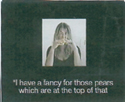 |
“The
Enchanted pear tree”
3 min, 2000
Woman eating a provocative pear with story/ text
based from Le Ciento Novelle antike 1525 by Carlos Gualteruzzi and music
Canario Lute transcription from Negri. |
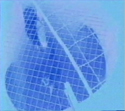 |
“The hole”,
1 min, 1999
An abstract short on
entrapment, time passing, and escapement. |









